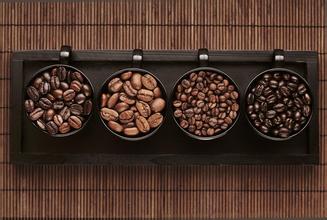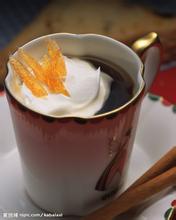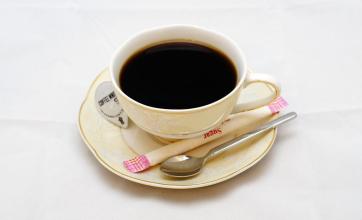Introduction to the difference between the standard dosage of coffee powder in siphon pot
Roughness is a good way to control bitterness, because the finer the grinding, the higher the extraction rate, the easier it is to extract high molecular weight bitter substances such as chlorogenic acid, quinic acid, caffeine and carbides. On the contrary, if the grinding is too rough, the lower the extraction rate is, the more difficult it is to extract the astringent bitter substance with high molecular weight, but the sweet taste with middle molecular weight may remain in the coffee grounds because of insufficient extraction, which is a waste. Therefore, baristas should pay attention to whether the thickness of the powder is normal every day. Too thick or too fine will cause abnormal extraction and affect the flavor of coffee.
The degree of grinding of all kinds of bubble cooking methods, from coarse to fine, in the following order:
French filter kettle (rough grinding), electric drip pot (medium), hand punch, siphon pot, desktop smart filter cup (medium), mocha pot (medium), espresso (fine), Turkish coffee (very fine).
According to the European Fine Coffee Association (SCAE-Speciality Coffee Association of Europe), the rough grinding of the French filter pot indicates that each bean is crushed into 100,300 particles, each about 0.7mm in diameter. In the medium rough grinding of the electric filter pot, each bean is ground into 500 grains of 800 particles, with a diameter of about 0.5 mm. Moderately ground by hand and siphon, each bean is ground into 1000 to 3000 particles with a diameter of about 0.35. The fine grinding of espresso in which each bean is ground into 3500 particles with a diameter of about 0.05mm. Turkish coffee is ground into a flour-like ultra-fine powder, with each bean ground into 15000 to 35000 particles. Generally speaking, the fineness of coffee powder cooked by siphon can refer to the thickness of "ultra-fine granulated" sugar sold on the market. According to the use of filter paper or filter cloth, adjust the thickness of the powder, the use of filter paper coffee powder needs to be finer than using filter cloth; you can adjust the taste of the final coffee liquid by adjusting the thickness of the powder.
two。 Siphon pot is generally divided into 2 people, 3 people and 5 people, each person's standard is 120ml water, how much coffee powder do you add? Gouache ratio 8:1-17:1, that is, 15-7 grams are fine. (remember it's the ratio of water to coffee powder, not the ratio of coffee liquid to coffee powder)
3. Dry the lower pot with a dry cloth (to prevent uneven burning of the lower pot), fix the filter with filter cloth or filter paper with a hanging chain, and make sure it is well fixed and in the center position. If it is not fixed well, the water temperature of the upper pot will be too high.
4. Fill the lower seat with hot water (not boiled water, which can reduce the heating time). Insert the upper seat obliquely into the lower seat and heat. When the bubble becomes bigger (definitely not boiling), insert the upper pot vertically into the lower pot; you can also directly add boiling water (if it is boiling water, the fire must be low at the beginning to prevent the upper pot from spraying water) or warm boiling water into the lower pot, so that you can insert the upper pot directly and then start heating, so that the temperature of the water reaching the upper pot is not the same.
5. The water rises into the upper pot, and about 1/3 of the water enters the upper pot and begins to use a thermometer to measure the temperature (if the bubble through the filter screen covered with filter cloth or paper is too large when the water rises, it is not a scattered small bubble, that is, the filter is not fixed or in the center, and can be adjusted with a wooden spoon) When almost all the water enters the upper pot, the water temperature should be 90-95 degrees. 92 degrees is the golden temperature. If the temperature is too low, you can continue to heat it. At this time, the rest of the water in the lower pot has already boiled, and the coffee liquid in the upper pot is kept from falling by steam pressure. (you can adjust the amount of coffee extract by adjusting the water temperature and adjust the taste of the coffee liquid.)

Important Notice :
前街咖啡 FrontStreet Coffee has moved to new addredd:
FrontStreet Coffee Address: 315,Donghua East Road,GuangZhou
Tel:020 38364473
- Prev

Iced coffee production method taste production area grinding treatment method introduction
In fact, in addition to not dissolving acidic fat, ice coffee also has the advantage of preserving the aroma of coffee in the coffee liquid. Because coffee brewed with hot water is generally brewed, part of the coffee aroma will be emitted during brewing, and ice coffee will not emit aroma during the process of dripping ice water.
- Next

Introduction to the trouble shooting and maintenance of clear water in Xike coffee machine.
Coffee machine maintenance SAECO, founded in Italy in 1976, has grown into a leader in the development and production of domestic and commercial coffee machines. The company's products are also the result of continuous innovation in high technology, especially the successful development of the brewing head at the core of the coffee machine, which is an innovation in the concept of making Italian coffee, realizing the full automation of grinding beans, pressing powder, brewing and discarding dregs.
Related
- What is the Philharmonic pressure? How to use Philharmonic pressure to make delicious coffee
- Why does a hand grinder have more fine powder than an electric grinder?
- In addition to the hot mom, what is the difference between the versions of EK43 | ditting and Mahdi ek43?
- What kind of equipment do you need to make coffee by hand? Introduction to novice starter cooking equipment tools
- Espresso needs to be ground how thick and thin scale entry Italian Coffee Machine Bean Grinder investigation and Grinding course
- How much does it cost to open a small private cafe? How much does it cost to learn coffee? How to operate it?
- The difference between the flavor characteristics of hand-brewed coffee and coffee maker is hand-brewed coffee really better than coffee maker? Can I use a coffee machine to make coffee beans by hand?
- The difference between 01 and 02 of hario v60 filter cup what is the difference between 01 and 02 filter cup opening and cooking flavor
- What's the difference between the smart cup and the French kettle? Which is better, the French kettle or the Smart Cup?
- What's the difference between a smart cup and a V60 filter cup? The difference between the taste of smart cup and hand-brewed coffee

